Understanding Diamonds: Their Significance and Trends
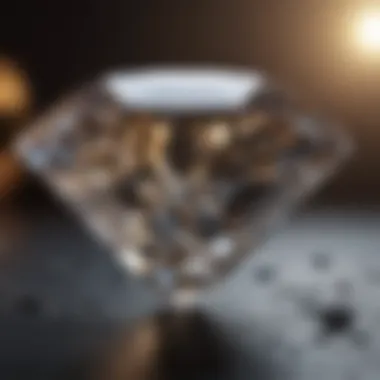
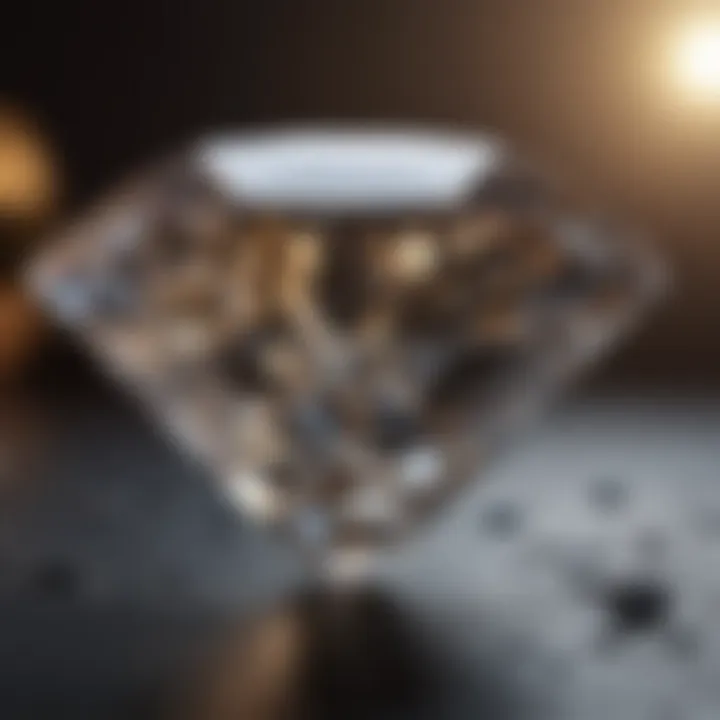
Gemstone Overview
Diamonds are among the most coveted gemstones in our world. To fully appreciate their value and allure, one must first grasp what gemstones are and how they fit into the broader category of precious stones.
Definition of Gemstones
Gemstones are naturally occurring substances that go through processes of formation and often require human skill to enhance their beauty. While many people think of diamonds first, the gemstone category includes a variety of stones such as rubies, emeralds, and sapphires, each with its own unique traits. Diamonds, specifically, are a crystalline form of carbon, renowned for their exceptional hardness and clarity, making them a favorite choice for jewelry.
Classification of Gemstones
Gemstones can be classified into two main categories: precious and semi-precious. Diamonds fall squarely into the precious category, along with other high-end stones. Some of the defining characteristics that illuminate the difference between these classifications include:
- Rarity: Precious gemstones are generally more rare than their semi-precious counterparts. Diamonds, while more abundant than some might think, maintain a perception of rarity in the marketplace.
- Durability: The hardness of diamonds makes them less prone to scratching compared to semi-precious stones, which can be more vulnerable.
- Market Value: The price tag on diamonds tends to be significantly higher than that of many semi-precious stones.
Historical Significance
The history of diamonds is as multifaceted as the stones themselves. Their use spans across time and cultures, revealing much about human civilization.
Origins of Gemstone Use
Historically, gemstones have been used not only for decoration but also as symbols of power and wealth. The first recorded use of diamonds as decorative elements can be traced back to ancient India, where they were incorporated into religious statues and revered as sacred. During the Middle Ages, diamonds began to emerge in Europe, quickly gaining status as a symbol of nobility and virtue. Kings would adorn themselves with diamond-studded crowns, believing in the stones' protective properties and their ability to attract good fortune.
Cultural Insights: Gemstones in Ancient Civilizations
In various ancient civilizations, gemstones were often attributed significant cultural meanings. For instance:
- Egyptians: Believed that diamonds were the tears of the gods, representing eternal love.
- Greeks: Associated diamonds with divine qualities, linking them to the power of the gods.
- Indians: Viewed diamonds as talismans that could enhance the wearer’s strength and wisdom.
Diamonds, over the years, have been woven into the fabric of stories, myths, and traditions, enriching not just the cultural tapestry but also fueling enthusiasm among collectors and enthusiasts. Their historical significance is often interlinked with the values and beliefs of those who sought after them.
Preamble to Diamonds
Diamonds, often called a girl's best friend, are more than just sparkling accessories; they are a complex amalgamation of geological history, cultural symbolism, and economic worth. Understanding the nature of diamonds is crucial not just for jewelry enthusiasts but also for collectors, designers, and those interested in the geology behind these precious stones. This section delves into the profound importance and significant aspects of diamonds, providing a solid groundwork for the topics that follow.
The allure of diamonds stretches far and wide. They symbolize luxury, commitment, and rare beauty, making them central to celebrations and milestones. Understanding diamonds means grasping their journey from raw mineral to a finished piece of art that captivates hearts and homes.
Diamonds hold a unique spot in human culture and history, and this significance is deeply intertwined with their characteristics and value. Different societies have attributed various meanings to this gemstone. For instance, in ancient India, diamonds were often thought to possess protective properties. Moving to the present day, they have become synonymous with engagement rings and ultimate expressions of love.
The Journey of Diamonds from Earth to Market
The life of a diamond begins deep within the Earth's mantle, forged under layers of intense pressure and heat over millions of years. Once formed, these stones embark on a captivating journey to reach consumers. Here are some key stages that depict this transition:
- Mining: Diamonds are extracted primarily from two types of deposits: primary and alluvial. Primary deposits are found in volcanic pipes, while alluvial deposits occur in riverbeds. Major mines can be found in countries like Russia, Botswana, and Canada, each contributing significantly to global supply.
- Sorting and Valuation: Once mined, rough diamonds go through meticulous sorting processes. Grading is primarily based on the Four Cs: cut, clarity, color, and carat weight. This classification affects not just the beauty of the diamond but also its market value.
- Cutting and Polishing: Diamond cutters use various techniques to shape the raw stones into polished gems. This step is crucial because the cut influences the stone's brilliance. A well-executed cut maximizes light reflection, producing the dazzling sparkle that diamonds are known for.
- Distribution: After cutting, diamonds reach wholesalers and retailers. Here, they are crafted into jewelry, helping them make their way into the market as top-tier luxury items. This is a competitive space, where trends shift rapidly, and consumer preferences drive sales.
"The path from rough stone to sparkling jewel is a narrative of human ingenuity and deep-rooted traditions, making each diamond not just a gem but a treasure of stories."
By comprehensively exploring the journey of diamonds—from their origins below the Earth’s surface to their final form in markets—readers can appreciate the intricate layers of value and history that each stone embodies. The significance of these gemstones is multidimensional, representing both natural marvels and profound human aspirations. Understanding this journey is essential for anyone looking to navigate the fascinating diamond world.
Scientific Properties of Diamonds
Diamonds are not just brilliant gems; they embody a unique blend of physical and chemical characteristics that elevate their status in both the jewelry and investment worlds. The scientific study of diamonds helps us to appreciate not just their beauty but the precision involved in their formation and trade. Understanding these properties can assist gem enthusiasts, jewelers, and investors in making informed decisions based on value and quality.
The Four Cs of Diamonds
The "Four Cs" are fundamental in assessing the quality of a diamond. Delve into each characteristic helps understand what affects value and desirability.
Cut
The cut of a diamond refers to how well it has been shaped and faceted. It's not merely about the diamond's shape; it significantly influences how light interacts with the stone. A well-cut diamond captures and reflects light brilliantly, creating a greater sparkle. The brilliance of a diamond can make or break its appearance. The ideal cut maximizes light performance, offering a mesmerizing display of fire and scintillation. This attribute is so vital because it can elevate a diamond's perceived value substantially.
However, too deep or too shallow cuts can hinder light performance, leading to a lackluster appearance. In this article, we emphasize the importance of cut because it enhances beauty and increases market appeal, making it a prized choice among collectors and jewelry designers alike.
Clarity

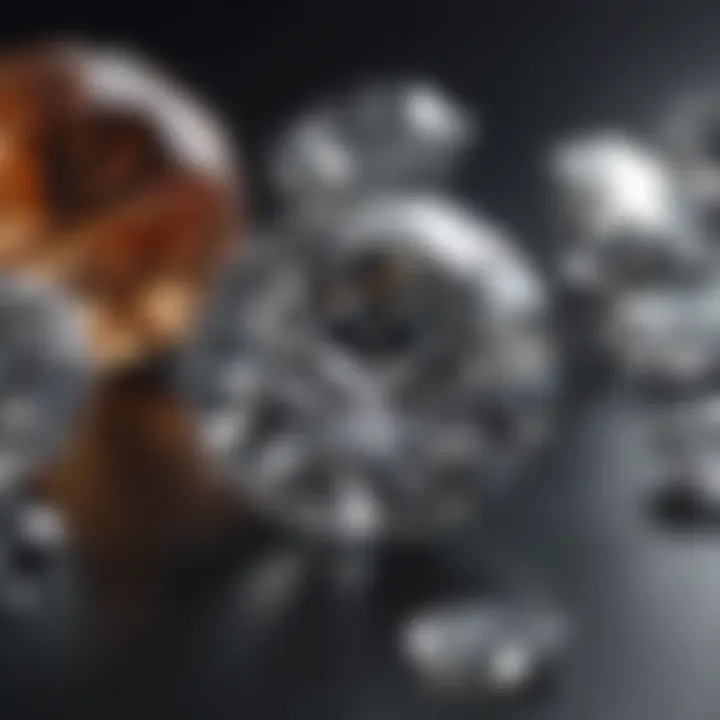
Clarity addresses the presence of internal or external imperfections, known as inclusions and blemishes respectively. A diamond with fewer or less visible imperfections is rarer and thus more valuable. Clarity impacts the overall optical performance of diamonds, influencing their sparkle and brilliance.
Diamonds graded as 'flawless' attract significant attention in the market, offering collectors and investors a potential return on investment. Yet it's essential to balance clarity with other factors like cut and carat weight, as a well-cut diamond with slight inclusions often appears more attractive than a poorly cut flawless stone. The unique features of clarity play a crucial role in the diamond's overall allure and market assessment.
Carat Weight
Carat weight measures the size of the diamond. It serves as one of the most straightforward indicators of value, with larger stones commonly fetching higher prices. However, carat weight is not the sole determinant of a diamond's value.
Many buyers may believe that bigger is always better, but carat weight should be paired with cut and clarity for an informed choice. Additionally, larger diamonds can be harder to find, making them more desirable. The unique appeal of size draws buyers, but it is crucial to understand the interplay with the other Cs to get the best value.
Color
Color refers to the natural hue of a diamond. While many may think that diamonds are always colorless, they come in a rainbow of shades, including yellow, brown, and even rare colors like blue or pink. The less color present in a diamond, the higher its value, particularly in traditional markets.
However, fancy colored diamonds can command astronomical prices depending on their hue and saturation. This aspect of color is equally intriguing as it adds depth to the investment decision.
Understanding color allows buyers to appreciate the spectrum available, ensuring they select a diamond that truly resonates with their style or investment strategy. Each diamond has a unique color that influences its character and market potential.
Understanding Diamond Grading
The grading of diamonds combines all the factors above and more. Institutions apply specific standards to assess and evaluate diamonds accurately. Knowledge of diamond grading allows collectors and investors to buy with confidence. Grading reports certify a diamond's quality, providing a detailed analysis that helps in understanding its true worth. As such, familiarity with grading systems can significantly align expectations with real market value.
A certified diamond narrows down the search for quality, ensuring that your investment is sound and its return is maximized.
The Historical Significance of Diamonds
Diamonds hold an emblematic place in human history, transcending mere adornment to embody power, wealth, and spirituality. Their allure has spanned centuries, influencing cultures and economies across the globe. Understanding the historical significance of diamonds can illuminate not only their value as gemstones but also their roles in shaping societal norms and practices. Through exploring their journey across different eras, we unravel how these magnificent stones have become a symbol of status and integrity, revealing richer narratives tied to human civilization itself.
Diamonds Through the Ages
Ancient Civilizations
In ancient times, diamonds were not just beautiful stones; they carried a weight of significance unlike any other gem. Early civilizations, such as those in India and Persia, believed these gems possessed mystical properties. For instance, in India, which is often credited as the original source of diamonds, they were thought to ward off evil and bring good luck. The uniqueness of diamonds during this time stemmed from their rarities and the belief that they were gifts from the gods.
- Key Characteristics: Their worth was not solely measured by appearance but by their perceived spiritual power.
- Contribution to Overall Topic: This contributes to the article's exploration by highlighting how cultural beliefs shaped perceptions of diamonds, framing them as invaluable treasures.
- Advantages: The ancient reverence for diamonds adds depth to our understanding of their multi-faceted roles in society
The ability of diamonds to captivate the hearts and minds of individuals in ancient civilizations paints a vivid picture of how their significance was deeply rooted in custom and belief. Their use in ornamentation during rituals and as trade goods indicated a valuable exchange that went beyond mere economics.
Medieval Symbolism
Moving to the medieval period, the symbolism of diamonds experienced an evolution. The key characteristic of diamonds during these centuries was their representation of purity and strength. Many royals donned them, asserting their status and divine right to rule. The famous Crown Jewels of England, for example, incorporated diamonds that were said to symbolize the monarch's greatness.
- Contribution to Overall Topic: This exploration reveals how the societal structures and beliefs during medieval times influenced the diamond's image, aligning it with royalty and power.
- Unique Features: The ornamental use of diamonds became more pronounced in jewelry, creating a lavish aesthetic that symbolized wealth.
- Disadvantages: On the flip side, this led to the perception that diamonds were not just adornments but also tools for reinforcing class distinctions.
Highlighting these narratives illustrates how diamonds transitioned from spiritual talismans to symbols of political authority. This shift reflects the changing tides of human belief and value systems, which are critical to understanding diamonds' current status today.
Modern Associations
In modern times, diamonds hold a different, yet equally significant, place in societal narratives. They became closely associated with romantic symbolism, particularly as engagement rings. Their brilliance and durability underscored a message of eternal love—a notion popularized in the 20th century through marketing campaigns.
- Key Characteristics: The 20th century's branding of diamonds as the ultimate engagement gift changed their landscape from luxury items to emotional symbols.
- Contribution to Overall Topic: Understanding this shift helps contextualize why diamonds remain immensely popular for significant life events today.
- Unique Features: The modern portrayal ties diamonds directly to personal relationships, emphasizing emotional investment rather than mere monetary value.
- Advantages: This ability to symbolize meaningful connections reinforces their desirability and widespread appeal in contemporary culture.
The modern associations with diamonds show their flexibility as cultural symbols, adapting through various lenses of societal expectations and personal significance over time. By tracing this historical journey, we comprehend the enduring mystique and relevance of diamonds in our lives today.
Cultural Narratives Involving Diamonds
As we delve into the cultural narratives involving diamonds, we find stories that encapsulate the aspirations, dreams, and even tragedies tied to these gems. Diamonds have not only adorned crowns and necklines but have also sparked wars, inspired artistry, and stirred desires. These narratives weave a complex tapestry of human experiences—be it the heartwarming tales of love or the poignant stories of conflict arising from the lust for these precious stones.
The exploration of diamonds through the lens of culture reveals much about human nature, desires, and our values over time. Each narrative serves as a reminder that diamonds are not just geological formations but intertwined with our very identities. The paths they have traversed across history play an essential role in framing the contemporary perspectives we hold today.
The Economics of Diamonds
The diamond trade encapsulates not only one of the most sought-after commodities but also a complex web of economic interaction that combines natural resources, craftsmanship, and consumer demand. Exploring the economics of diamonds is crucial for understanding both their market value and cultural significance. It helps clarify how diamonds connect diverse global communities—from miners in remote regions to affluent consumers in bustling cities. Here, we will delve into the supply chain of diamonds and the investment potential they carry, providing a comprehensive overview for enthusiasts and investors alike.
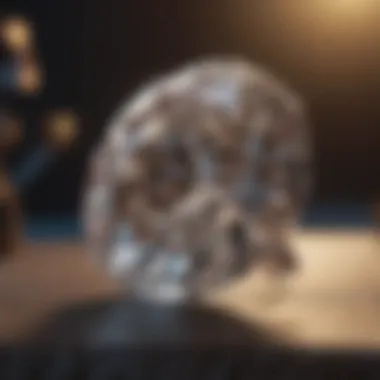
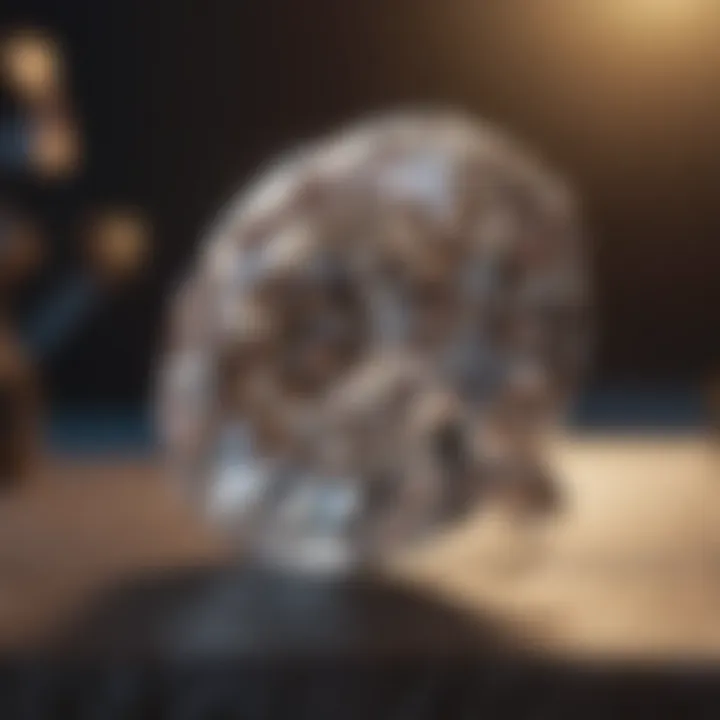
The Diamond Supply Chain
Mining Practices
Mining practices represent the very foundation of the diamond economy. They define how and where diamonds are sourced, which consequently affects every level of the supply chain. Mines around the world, such as those in Botswana and Russia, employ various methods, including open-pit and underground mining.
Key characteristics of these practices revolve around their environmental footprint and the challenges faced by labor forces. Ethical mining initiatives have gained traction, advocating for fair labor and sustainable methods. For those interested in both the beauty of diamonds and the ramifications of their sourcing, understanding these practices is of utmost importance.
However, despite advancements, many mining practices remain fraught with difficulties—financial instability for miners, ecological damage, and, at times, a lack of regulation. The sustainable approach to mining is still a work in progress, highlighting the delicate balance between profit and responsibility in this industry.
Distribution Channels
The distribution channels of diamonds are as intricate as the journey they undertake— from the mine to the consumer's hands. Individual diamonds often traverse several steps, including processing, wholesaling, and retailing before reaching the final buyer. Each of these stages adds value but also heightens the complexity.
A prominent distribution channel is the auction houses, such as Sotheby's and Christie's, showcasing rare and unique pieces, attracting high-net-worth collectors.
Additionally, branded jewelry retailers like Tiffany & Co. use exclusive designs and marketing allure to create perceived value. However, while these distribution channels can bolster a diamond's prestige, they can also introduce substantial markups.
A unique yet challenging feature is the rise of online marketplaces—such as James Allen and Blue Nile—where buyers can purchase diamonds directly, minimizing overhead costs. Yet, this can lead to an overwhelming array of choices for potential buyers, requiring them to educate themselves on quality and procurement.
Market Dynamics
Market dynamics in the diamond industry are shifting, influenced by a mix of economic forces and societal trends. Global demand for diamonds can fluctuate based on various factors, including changing consumer preferences, economic conditions, and emerging markets like China and India. Understanding these nuances is essential for any investor or enthusiast.
The key characteristic of this market is its responsiveness to economic shifts. During economic downturns, luxury goods, including diamonds, often see declines in demand, as they are considered non-essential.
The unique feature of the diamond market is its connection to emotional milestones—engagements, weddings, and anniversaries. Diamonds are wrapped up in personal sentiment, which can stabilize their demand. However, it's also worth noting the rising allure of synthetic diamonds, which are changing the landscape and possibly influencing prices of natural diamonds in the long run.
Investment Value of Diamonds
Diamonds are not solely about romance and luxury; they carve a notch in investment portfolios as well. Historically, diamonds have been viewed as a store of value, akin to gold. While they might not be as liquid, investing in high-quality diamonds can potentially yield favorable returns over time. The appeal lies not just in the material worth of a diamond but also its intrinsic charm and rarity.
Key considerations for investors include understanding the quality elements—such as the four Cs along with market trends. They must also navigate educating themselves about grading and certification, as these facts will hold weight when it comes to resale.
Some investors are even looking into diamond-backed securities or funds, providing an innovative way to invest without having to hold physical diamonds. However, it remains crucial to tread carefully, as the diamond market is not regulated to the same extent as traditional securities, and maintaining a discerning eye is essential.
In sum, the diamond trade is much more than glitz and glamour. It weaves together social, economic, and ethical considerations that resonate with both enthusiasts and collectors. As the landscape continues to evolve, informed decision-making in this arena becomes increasingly valuable.
International Regulations and Ethical Considerations
The diamond industry embodies a tapestry of beauty and wealth, but within this glittering facade lies a web of ethical dilemmas and regulatory challenges. As diamonds traverse from mines to market, various global forces shape their journey. Understanding the international regulations and ethical considerations surrounding diamonds is crucial not just for consumers, but also for those who appreciate the intricate story each gem tells.
Conflict Diamonds: Origins and Impacts
Conflict diamonds, often referred to as blood diamonds, have stirred significant concern and debate over the years. This term denotes diamonds mined in war zones and sold to finance armed conflict against governments. These stones symbolize tragic narratives, namely the suffering of local populations caught in the crossfire.
In the late 1990s, the issue gained wide recognition, leading to international initiatives aimed at curtailing this trade. The Kimberley Process Certification Scheme was established to prevent the entry of conflict diamonds into the legitimate diamond market. Through careful tracking and certification, the aim was to ensure that diamonds traded globally do not fund violence and human rights abuses.
Nonetheless, flaws persist in this scheme. For instance, loopholes in the certification process mean that some conflict diamonds may still find their way into the market, often through neighboring states or fraudulent certificates. This reality raises critical questions:
- How effective are current regulations in stopping the flow of conflict diamonds?
- What more can be done to protect vulnerable communities?
These questions need addressing, as the repercussions go beyond just economic implications; they touch upon moral responsibilities that consumers and corporations must navigate.
"The diamond's sparkle can mask the dark narratives of its origin, reminding us why transparency is key in ethical sourcing."
Ethical Sourcing Initiatives
In response to the challenges posed by conflict diamonds, there has been a marked shift towards ethical sourcing. Companies and organizations are increasingly recognizing the value of ensuring that their diamonds are sourced responsibly. Several initiatives have sprung up, advocating for transparency and traceability in the diamond supply chain.
Among these initiatives, one can find the Responsible Jewellery Council and various Fair Trade certification programs. These efforts encourage:
- Transparent sourcing: Companies must provide a clear chain of custody for their diamonds, making it easier for consumers to know the origins of their gems.
- Community support: Ethical sourcing is often coupled with projects that benefit mining communities, fostering better living standards and stability.
- Environmental impact: Many initiatives prioritize sustainable mining practices, ensuring minimal harm to local ecosystems.
Moreover, as the demand for ethically sourced diamonds grows, some retailers are offering lab-grown diamonds as a viable alternative, sidestepping many ethical concerns linked to traditional mining. Lab-grown stones are chemically identical but carry a significantly lower environmental footprint and no risk of financing conflict.
Ultimately, ethical sourcing not only shapes the narrative of where a diamond comes from but also provides a pathway for consumers to make informed choices, aligning personal values with purchase decisions. This evolution creates an opportunity for industry stakeholders to foster a diamond market that cherishes both beauty and integrity.
Contemporary Trends in Diamond Jewelry
In the shifting landscape of fashion and personal expression, the realm of diamond jewelry is not spared from innovation. The emphasis on contemporary trends signifies more than just a fleeting interest; it shapes how diamonds are perceived and worn across various demographics today. By exploring these trends, one gains insights into the evolving values, aesthetics, and desires of modern consumers. Understanding current practices in design not only enriches the experience for enthusiasts but also informs collectors and designers alike about the market's direction.
The growing inclination toward sustainability pushes designers to rethink traditional methods of sourcing, cutting, and crafting. This movement aims to create pieces that not only look exquisite but also align with ethical standards. Increasingly, consumers are seeking transparency in diamond origins, leading to a surge in lab-grown diamonds that mimic nature’s creations but with a smaller environmental footprint. This change in production process sheds light on a broader commitment to responsible consumption.
Emerging Styles and Design Innovations
The diamond jewelry scene is buzzing with fresh perspectives and innovative designs. A couple of significant trends are particularly noteworthy:
- Minimalism: This has become a favorite among many. Clean lines, delicate settings, and understated brilliance prioritize the diamond itself, allowing its natural beauty to shine without distraction.
- Mixed Metals: By combining different metal tones, such as rose gold with white gold or platinum, jewelers create dynamic contrasts that highlight the stones in an unexpected and modern way.
- Geometric Designs: Funky shapes and intricate cuts are becoming more popular, steering away from traditional round or princess cuts. Think of diamonds cut into hexagons or trapezoids, which lend an avant-garde touch to rings and earrings.
The customization trend is on the rise as well. Jewelry enthusiasts want pieces that tell their personal stories. A ring designed to encapsulate significant life events, for instance, allows wearers to showcase their individuality. This aspect of customization fuels creativity among designers who are more inclined to explore unconventional settings and arrangements.
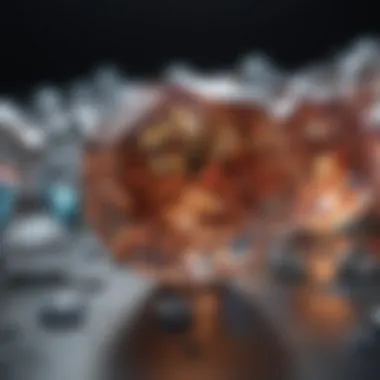
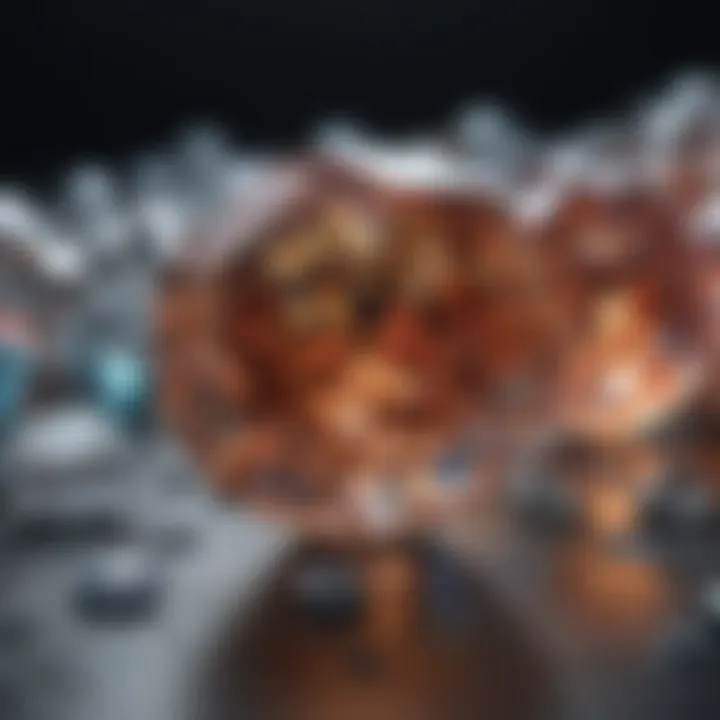
"The modern diamond isn’t just a gem; it's a canvas for expression that tells a unique tale."
Moreover, the online marketplace has transformed how diamond jewelry is purchased and perceived. Engaging social media platforms like Instagram and Pinterest have broadened the reach for jewelers, making them more accessible to the average consumer. Here, consumers often discover unique artisans committed to crafting distinctive pieces that echo current aesthetics while also holding personal significance.
Finally, vintage-inspired designs are making a noteworthy resurgence, with many opting for styles reminiscent of the Art Deco or Victorian eras. These pieces, laced with history, offer a blend of nostalgia and timeless appeal, drawing in consumers who appreciate depth and story.
The Role of Technology in Diamond Assessment
In the intricate world of diamonds, technology plays a crucial role in the assessment of these precious stones. The way diamonds are evaluated today is miles apart from the era when the human eye was the primary tool for appraisal. Various advancements have ushered in a new age of precision and clarity, ensuring that buyers can confidently invest in their sparkling treasures. This section explores the specific elements of technological progress in diamond assessment, highlights various benefits, and lays out some key considerations regarding this modern approach.
Advancements in Cutting Techniques
The cutting of diamonds is not just about shaping them; it is an art form intertwined with science. Advancements in cutting techniques over the years have transformed how diamonds are crafted and subsequently assessed. Here are some of the pivotal advancements:
- Laser Technology: The use of lasers in the diamond cutting process has brought about extraordinary precision. Laser cutting can replicate intricate patterns, allowing for a level of detail previously unattainable. This precision translates into a clearer, more brilliant diamond, enhancing its appeal.
- Computer-Aided Design (CAD): With the advent of CAD, jewelers can now design and visualize diamond cuts in a virtual environment before any physical manipulation occurs. This ensures that the final product closely aligns with the initial design concept, preserving both the aesthetic and value of the diamond.
- Optimization Software: Specialized software assists gemologists in analyzing the proportions of a diamond more effectively. By manipulating virtual models of diamonds, professionals can identify the ideal cut parameters to maximize brilliance and minimize waste during cutting.
- Automated Proportional Analysis: Automated tools can now measure the proportions of a diamond with a level of accuracy that a human simply cannot achieve consistently. This data can be cross-referenced with industry benchmarks to establish a diamond’s quality efficiently.
"Technology has rekindled the flame of diamond craftsmanship, yielding results that are awe-inspiring and value-rich."
While these advancements are fascinating, they bring certain considerations as well. For instance, the reliance on technology raises questions about the balance between human expertise and machine efficiency. Is the warmth of a craftsman’s eye irreplaceable by a computer algorithm? Perhaps, the answer lies in a harmonious blend of both methodologies. Moreover, as we dive deeper into tech-driven assessments, the importance of maintaining ethical practices in sourcing and production cannot be overlooked.
Caring for Diamonds: Maintenance and Preservation
Caring for diamonds is a crucial aspect often overlooked by casual enthusiasts. Beneath the sparkle and dazzle lies a responsibility that every owner should consider seriously. Diamonds, while famed for their strength and resilience, are not impervious to dirt, oils, or scratches that can dull their brilliance. Proper maintenance and preservation can extend a diamond’s lifespan and enhance its aesthetic appeal, making it an invaluable part of your collection.
When you think about the emotional weight a diamond carries—be it a family heirloom or a recent engagement ring—the significance of caring for it becomes evident. Neglecting even a small amount of care can turn a magnificent stone into one that lacks luster. This is especially important considering the investment that often goes into fine diamond jewelry, where proper upkeep translates to sustained value.
Cleaning and Storage Tips
To ensure your diamonds always look their best, follow some basic yet effective cleaning and storage tips:
- Routine Cleaning: Regular cleaning removes accumulated dirt and oils. A simple method includes mixing mild dish soap with warm water. Use a soft brush, like a toothbrush, to gently scrub the diamond and its setting. Rinse thoroughly and dry with a lint-free cloth for a brilliant shine.
- Avoid Harsh Chemicals: Stay clear of bleach or abrasive cleaners. These can harm both the diamond and its setting.
- Store Properly: Diamonds should ideally be stored separately in a plush-lined box or pouch. This practice helps avoid scratches that can arise from contact with other jewelry.
- Timing Matters: Take off your diamond jewelry during activities that may expose it to damage—like gardening, exercising or even showering. Simple habits like this can do wonders for preservation.
- Have It Professionally Inspected: At least once a year, take your diamonds to a professional for cleaning and inspection. This not only maintains brilliance but can also reveal potential issues like loose settings or scratches that might not be obvious to the untrained eye.
"The gem's glow is only as good as the care it receives."
- Keep Away from Direct Heat: Avoid exposing diamonds to extreme temperatures or direct sunlight. This is especially relevant for diamond rings that may be kept near heating vents or hot appliances.
When these tips are followed diligently, not only do you maintain the beauty and integrity of your diamonds, but also the stories and memories attached to these stunning gems. Thus, investment in proper care is truly an investment in the future brilliance and legacy of one of nature’s most exquisite creations.
The End: The Enduring Allure of Diamonds
Diamonds have fascinated humanity for centuries, maintaining a unique position in both our culture and economies. Their appeal goes beyond mere aesthetics; these gemstones embody a complex blend of scientific intricacies, historical narratives, and emotional connections. To grasp their ongoing allure, one must consider several key elements that contribute to their lasting significance.
Firstly, the physical properties of diamonds—such as their hardness and brilliance—are unparalleled in the gemstone realm. This durability not only boosts their desirability but also symbolizes strength and eternity, making them a popular choice for engagement rings and other meaningful jewelry.
Secondly, cultural significance cannot be understated. Across various societies, diamonds have been symbols of wealth, status, and love. From the crowns of ancient kings to today’s luxury items, their meanings have evolved, yet they retain a deep-rooted connection to human expression.
Benefits of Understanding Diamonds
Grasping the complexities behind diamonds offers several benefits to enthusiasts and investors alike:
- Informed Purchasing: Understanding the Four Cs—cut, clarity, carat weight, and color—positions buyers to make informed choices, ensuring that they acquire a stone that meets their desires without overspending.
- Investment Insight: As this article highlighted, diamonds represent a tangible asset. Knowledge about market dynamics can aid in recognizing value trends, potentially leading to wise investment decisions.
- Ethical Considerations: Awareness of the mining and trading practices encourages consumers to support ethical sourcing initiatives, contributing positively to communities and the environment.
Ultimately, the allure of diamonds lies not just in their beauty but also in their rich narratives and multifaceted significance. These stones challenge us to reflect on what is valued in society, both materially and emotionally. As we navigate the intricate world of diamonds, we discover a realm where science, history, and personal connection intertwine, reminding us that some treasures truly transcend time.
"Diamonds are a reflection of nature’s artistry, shaped by time and circumstance, yet they remain a personal emblem for each wearer's story."
Reflecting on the Multifaceted Nature of Diamonds
Diamonds, often hailed as one of nature’s masterpieces, encapsulate a spectrum of elements that extend far beyond their physical characteristics. They touch upon themes of innovation, the clash of societal values, and individual storytelling.
Each diamond carries its own journey—their formation deep within the Earth, the skilled hands of artisans who cut them, and the markets that circulate them. Understanding this journey adds layers to the appreciation of these gemstones.
Historical Context
The historical narrative surrounding diamonds is replete with tales of conquest, romance, and symbolisms that shaped cultures. Here are some aspects worth delving into:
- Ancient Beliefs: In various ancient civilizations, diamonds were believed to possess magical qualities, offering protection and comfort to their bearers.
- Modern Symbolic Uses: In contemporary times, diamonds signify romantic love, often celebrated through engagement rings that signify commitment and promise.
Contemporary Relevance
Today, the diamond industry is also adapting to meet modern demands. Sustainable practices and ethical sourcing have become paramount for new generations of consumers who value transparency. This shift not only addresses past wrongs but allows diamonds to reclaim their place in society as a responsible luxury.



